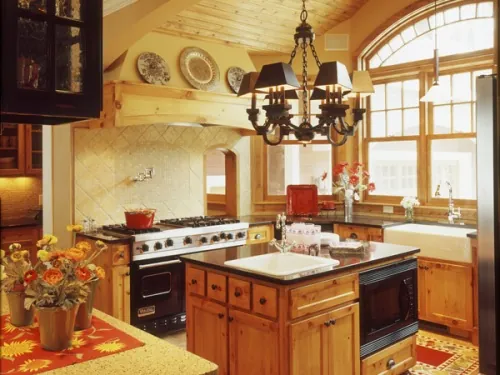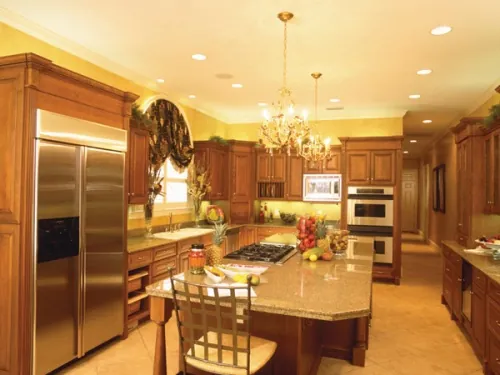While many people enjoy cooking, almost everyone has experienced kitchens that are absolute nightmares to work in.

View this House Plan
View Other Tudor House Plans
Cramped spaces, unorganized tools, and minimal counter surfaces compel even the best chefs to order take-out. Experiences like that leave many homeowners calling for a kitchen floor plan that is seemingly effortless to work in. As part of building your dream home, it is a great time to incorporate your dream kitchen.
In order to have a truly efficient kitchen, it is necessary to customize your kitchen floor plan to your personal style. Just as no two chefs cook alike, neither are two kitchens the same. To begin planning your customized kitchen, first evaluate how you use the space:
- How many cooks use your kitchen at one time?
- Is your kitchen multi-use – for example, do some family members hang out to chat or work on different tasks while others cook?
- What is your cooking style (gourmet, quick dinners, mostly baking, etc.)?
- What appliances do you often rely on?
- Track your common movements while cooking: Do you find yourself moving back and forth to the refrigerator frequently? Do cooking and cleaning duties clash at the sink? Are other family members under foot? What equipment do you struggle to retrieve when you need it most?
Answering these questions will help determine what kitchen layouts will work best in your home. With your answers in mind, take a look at two standard kitchen set-ups:
The Work Triangle
The stove, sink, and refrigerator are placed at the points of an invisibly drawn triangle, maximizing efficient movement within the kitchen. This layout assumes there are only three major cook stations and one cook, appealing to smaller kitchen spaces.

View this House Plan
View Other Southern House Plans
- The sum of the triangle's three sides should not exceed 26 feet; each leg should be between four and nine feet long.
- Major traffic ways should not cut across the triangle, limiting disruption of the cook's work.
- No leg should cut through an island by more than 12 inches.
- A solo sink should be placed across from the cooktop or refrigerator.
Work Stations
Work stations are appropriate for bigger, busier kitchens and arranged into "zones" for maximum efficiency. These zones run the spectrum from early preparations to the final stages of dining and cleaning. Each kitchen task is centered on a major appliance with an adjacent countertop space of at least 15 inches.

View this House Plan
View Other Victorian House Plans
- Food Preparation – Where all the work begins!
- Most often the food preparation zone is an ample countertop located near the refrigerator and pantry. If you have space for an island, it is ideal for this zone.
- A trash center should be included for food scraps and packaging.
- A small second sink specifically for preparing food is handy in this zone, leaving the larger sink for cleaning and cooking needs.
- Butcher-block inlay or pullout keeps the cutting board easily accessible at all times.
- Drawers in this area should be set aside for knives, mixing, and measuring utensils.
- Cooking – Centered around a cooktop or range.
- Storage in this area should include space for such appliances as microwaves and toasters. Look into under-counter/built-in microwaves to free up countertops.
- Cooking utensils should be placed in drawers that are easily accessible to the cook.
- Spice drawers keep the counters clear while spices remain easy to find.
- Typically adjacent to the sink (cleaning zone), a "pot-filler" or kettle faucet can be run near the range, allowing large pots to be filled without heavy lifting.
- Baking – A mix of the prep and cooking zones and centered on the oven, the baking zone is not a must-have in many kitchens, but is certainly appreciated by frequent bakers.
- Marble pullouts or inlays are best for rolling dough of any consistency.
- Ingredient containers (flours and sugars) can be stashed in a cabinet within reach or decoratively arranged on the counter top.
- Small drawers are great for storing and organizing accessories like cookie cutters, rolling pins, and baking parchments that will only be used in this zone.
- Pull out racks that arrange baking sheets and other pans keep cabinets tidy.
- If including a baking zone in your dream kitchen, this is the place for that bulky mixer every baker has in the arsenal of appliances. A pop-up stand may be the way to go if you prefer to keep your countertops clear.
- Cleaning – Where the sink and dishwasher join forces.
- Where there is water, there will be a need for dishtowels. A drawer off to the side will keep these handy and dry until needed.
- Keep cleaning supplies under the sink to make scrubbing chores less of a hassle.
- Foil, plastic wrap, and leftover containers should be kept nearby to make storing food easier and less messy when done over the sink.
- Appliances such as the coffee pot are easier to set when located by the water source.
Using these two setups, kitchens can be shaped differently based on location within the home. U- and L-shaped kitchens are very popular and utilize either the work triangle or work stations. Islands are also options for both setups as long as space permits.
After evaluating your own kitchen needs and observing the different ways one can arrange their kitchen, it is time to decide just what you plan to do with yours. Make arrangements to discuss your current kitchen habits and your dream setup with a professional designer. They can evaluate the space you have to work with and help you layout the most efficient kitchen floor plan. Remember that space in a kitchen is key, so there may be limitations to some arrangements. Do not hesitate to sketch your own layout to give the designer or contractor a better idea of what you want.
Once you have determined the basic organization of your kitchen, it is important to discuss smaller details as well. Energy efficient appliances, task lighting, and little luxuries like wine coolers and warming drawers can easily be integrated into your dream kitchen floor plan.
Here are some related articles:
Save this article to:
back to top